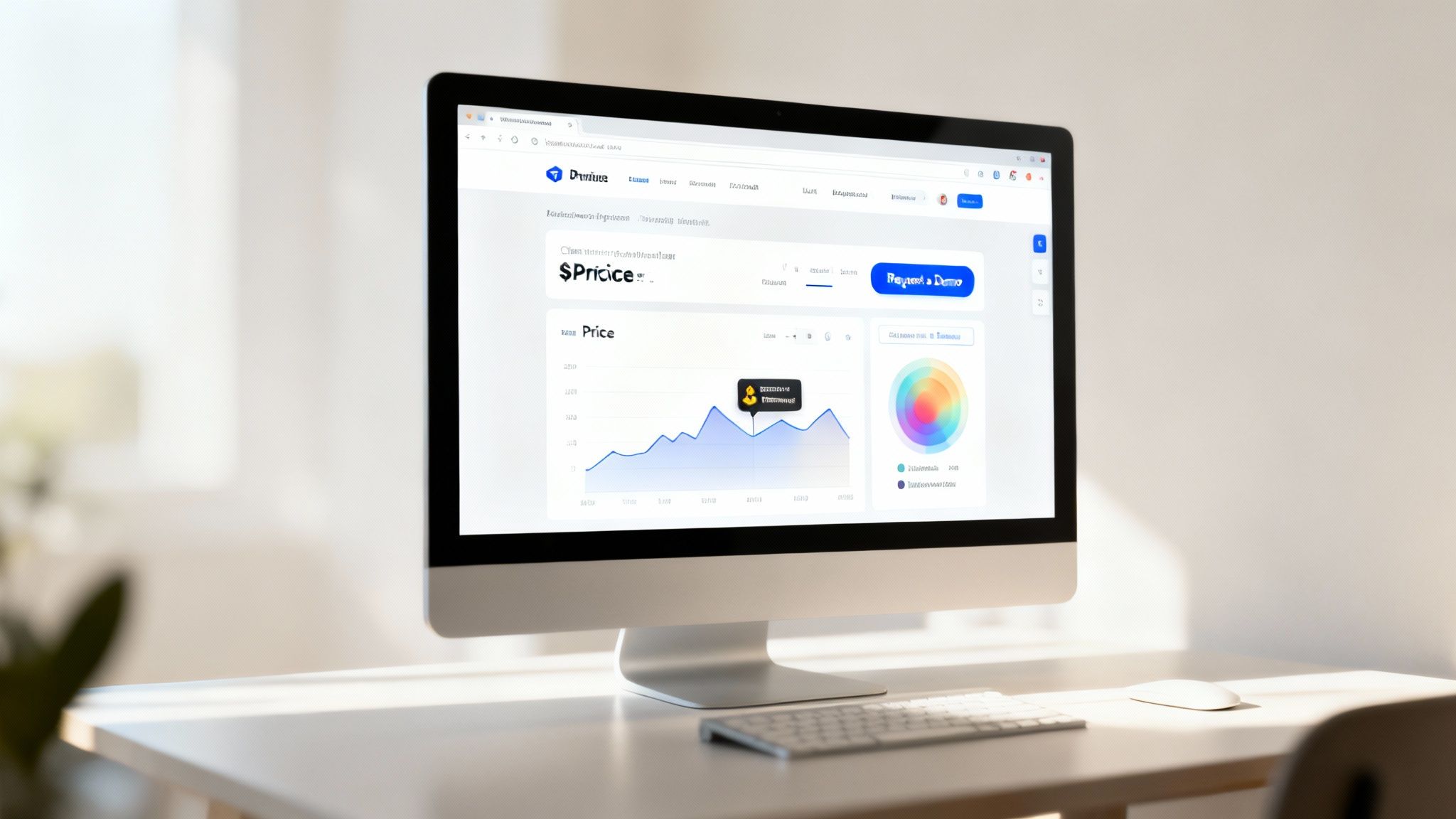What Is a Buying Signal? Key Tips to Identify Them Quickly
Discover what is a buying signal and learn how to recognize verbal and digital cues in B2B sales to close deals faster and boost your pipeline.
best signals for enterprise sales: uncover top data sources like SEC filings and job posts to identify high-intent accounts and close bigger deals.
TL;DR: Stop guessing and start selling with precision. This guide reveals the top 10 enterprise sales signals—from SEC filings and job posts to tech stack changes—that show you exactly when a high-value account is ready to buy, so you can engage at the perfect moment.
Selling to enterprise-level companies often feels like navigating a maze in the dark. You send countless emails, make endless calls, and hope something lands. But what if you could flip a switch and see the path clearly? That's the power of sales signals. Instead of guessing, you can act on specific triggers that indicate an organization is ready to buy, is facing a challenge you can solve, or is investing in an area where your solution fits perfectly.
These signals are hiding in plain sight within the vast sea of public information: news articles, earnings reports, leadership podcasts, job postings, and SEC filings like 10-K and 10-Q reports. The challenge isn't a lack of data; it's knowing how to gather, mine, and act on it. Platforms like Salesmotion excel at this signal-based selling, while tools like Amplemarket focus on social triggers and Cognism provides robust contact data to complete the picture. To truly stop guessing and start selling, enterprise teams must master the art of harnessing combined internal and external data for decisive action, much like forward-thinking banks are doing.
This article cuts through the noise. We will provide a detailed breakdown of the best signals for enterprise sales, explaining why each one matters and giving you actionable steps to leverage them. You'll learn how to identify critical buying triggers and tailor your outreach for maximum impact, turning cold prospects into warm conversations.
What it is: Technographic data is a map of a company's software and hardware stack. A change—like adding a new CRM or dropping a competitor's tool—is a powerful signal. It means they're in an active buying cycle, making a strategic shift, or trying to solve a pressing problem. This is your cue to engage with a perfectly timed and relevant message.

Why it matters: When a company migrates from one major tool to another, it shows they are re-evaluating core operations. This is a prime opportunity to introduce complementary solutions. Similarly, if a target account posts jobs requiring skills in a new technology you integrate with (like AWS or Salesforce), it confirms a strategic investment and an immediate need for supporting tools.
Effectively using technographic signals requires a proactive approach. Don't just see what tools they have; understand why and when they change them.
Key Insight: A technology change is a symptom of a larger business strategy. Focus your outreach on the underlying goal (e.g., "scaling your sales team") rather than just the technology. For a deeper dive, learn about tracking account technologies on salesmotion.io.
What it is: Funding rounds (VC, IPO, acquisitions) and public financial filings (10-K, 10-Q reports) are powerful indicators of imminent growth and spending. These events inject companies with fresh capital earmarked for expansion, new projects, and strategic initiatives. An organization that has just secured funding is actively planning how to deploy that budget to scale operations, hire talent, and invest in new technology.

Why it matters: When a company like GitLab completes its IPO, it signals a major push toward accelerating enterprise customer acquisition. These events aren't just about money; they represent a board-level commitment to aggressive growth, making them highly qualified targets for solutions that facilitate expansion. Similarly, an earnings call might reveal a new strategic focus, while a 10-K report can detail risks and opportunities the company is prioritizing.
Capitalizing on financial signals requires speed and a clear understanding of how post-funding companies allocate resources.
Key Insight: A funding event is a public declaration of ambition. Frame your solution as an essential investment to maximize the ROI on their new capital. For a closer look at corporate financials, learn how to analyze earnings calls for pipeline generation.
What it is: A change in the C-suite or key leadership ("people moves") is one of the most reliable sales signals. New executives are hired to drive change. They arrive with a fresh budget, a mandate to make an impact within their first 90 days, and a network of preferred vendors. This creates a window where old processes and tools are scrutinized and new solutions are actively sought.
Why it matters: A new CMO often signals a marketing stack overhaul. A new CIO is frequently tasked with modernizing infrastructure. A new CFO may prioritize tools for financial visibility. These transitions are public declarations of strategic shifts, making them invaluable triggers for well-timed, relevant outreach.
Capitalizing on leadership changes requires a mix of timely monitoring and strategic patience. The goal is to connect your solution to the new executive's likely priorities.
Key Insight: Don't reach out on day one. A new leader needs time to assess the landscape. The sweet spot for outreach is often 30-90 days into their new role. Ensure you have the right contact info with tools like Cognism for accurate contact data.
What it is: An enterprise account's digital footprint on your own website is one of the most direct buying signals. Indicators like repeat visits from the same company, specific content downloads (like case studies or whitepapers), and time spent on your pricing page reveal active research and purchase consideration. These signals show a prospect is moving from passive awareness to active evaluation.

Why it matters: When multiple stakeholders from a target account start downloading security resources, it signals a deeper internal evaluation is underway. An account repeatedly viewing your ROI calculator is demonstrating high purchase intent. These actions are tangible evidence of a team building a business case for your solution, allowing your sales team to engage at the perfect moment.
Effectively using website behavior requires the right tools to de-anonymize traffic and a clear process for acting on the insights.
Key Insight: Digital engagement is a direct reflection of a prospect's current priorities. Outreach that references their specific on-site behavior (e.g., "I saw your team was exploring our integration with Salesforce...") is far more effective because it proves you're addressing a known interest.
What it is: Intent data captures an organization's research process across the web. These digital breadcrumbs—like search queries and content consumption on third-party sites—pinpoint accounts that are already problem-aware and solution-seeking. It’s an early warning system that tells you who is moving from passive interest to active evaluation.
Why it matters: When key decision-makers at a target account start researching "cloud migration best practices" or "enterprise data security solutions," it signals a clear, present need. This isn't a vague interest; it's a direct indicator of an active project. These signals move an account from a long-term nurture list to a high-priority outreach queue.
Using intent data effectively means understanding the context behind the research spikes. It's about connecting their digital behavior to a business problem you can solve.
Key Insight: Intent data tells you what a company is thinking about before they ever contact you. Your job is to connect their research to a tangible business initiative and start a conversation. To learn more, explore this overview of what is intent data on salesmotion.io.
What it is: A company's hiring activity is a direct reflection of its strategic priorities and budget allocation. Analyzing job postings offers a transparent view into where a company is investing. These public breadcrumbs reveal expansion plans, new initiatives, and pain points long before they are announced.
Why it matters: When a company posts listings for ten new sales engineers, it signals an impending platform expansion. A sudden wave of hiring for a data science team confirms a major investment in analytics. These aren't just HR activities; they are clear indicators of where a company is placing its bets and where budget is flowing.
Effectively using hiring data means looking beyond the job title to understand the underlying business initiative.
Key Insight: Hiring patterns reveal a company’s future direction. Outreach that aligns with the goals of a newly formed or expanding team shows a deep understanding of the prospect's immediate business needs.
What it is: Identifying accounts that use a competitor's product is a powerful entry point for strategic outreach. These signals present a clear opportunity for displacement. Instead of creating a need from scratch, your goal is to showcase superior value and address pain points the incumbent solution fails to solve.
Why it matters: When an account outgrows its current tool or leaves negative reviews for a competitor on G2, they become actively open to alternatives. This insight allows you to position your product not just as another option, but as the direct answer to their known problems.
Capitalizing on competitor signals requires a combination of intelligence gathering and precise, value-driven messaging.
Key Insight: A competitor's customer is a pre-qualified lead with a demonstrated budget and need for your type of solution. Your job is to prove that a switch will deliver significantly more value.
What it is: Regulatory and compliance events are non-negotiable business drivers that force organizations to act. New laws (like GDPR), industry mandates, or audit requirements create immediate and urgent needs for solutions that ensure compliance. These are compulsory buying triggers with a fixed deadline.
Why it matters: When healthcare providers must adhere to new HIPAA standards or financial firms face updated SEC reporting rules, they have no choice but to invest in new systems. These external pressures override internal politics and budget freezes, creating a clear path for a well-positioned sales team.
Capitalizing on regulatory signals requires foresight and a deep understanding of your target industries.
Key Insight: A compliance deadline creates internal urgency. Frame your outreach around risk mitigation, showing how you can help them avoid penalties and turn a regulatory burden into an operational advantage.
What it is: Firmographic data includes a business's core characteristics: company size, annual revenue, industry, and location. These attributes act as a first-pass filter, ensuring your team only pursues accounts that align with your ideal customer profile (ICP). They define your addressable market and predict which companies have the budget and need for your solution.
Why it matters: Focusing on firmographics prevents wasted effort. A SaaS platform for large healthcare systems won't gain traction with small financial firms. Aligning outreach with clear firmographic criteria—like "manufacturing companies with over $100M in revenue"—ensures every conversation starts with a baseline level of product-market fit.
Using firmographics effectively means integrating them into a dynamic targeting strategy.
Key Insight: Your ICP is not static. Re-evaluate it quarterly based on your win-loss data. To refine your targeting, check out this ultimate account research checklist on salesmotion.io.
What it is: A Request for Proposal (RFP) is a clear declaration that a company has an approved budget, defined requirements, and an active intention to purchase a solution. Unlike other signals that suggest potential interest, an RFP moves a prospect from a "maybe" to a "buy now" category.
Why it matters: When a government agency posts a software RFP or a large enterprise distributes a vendor request, they are officially in the market. Responding to these signals means you are entering a competitive but well-defined sales process with a high probability of closing if your solution is the right fit.
Capitalizing on procurement signals requires speed, preparation, and strategic relationship-building.
Key Insight: An RFP is the final exam, but the real work happens beforehand. If you're only learning about a company's needs when the RFP is released, you're already behind.
We've covered the best signals for enterprise sales, from technical details in SEC filings to human shifts in executive moves. Each signal is a window of opportunity—a chance to transform your outreach from a cold interruption into a timely, relevant conversation.
The modern enterprise buyer broadcasts their priorities through earnings calls, news, podcasts, and hiring patterns. The challenge is no longer a lack of information but an overabundance of it. Winning requires a systematic approach to gathering, mining, and—most importantly—acting on this intelligence.
Simply knowing a company hired a new CIO isn't enough. Elite sellers connect the dots to build a compelling narrative.
Ultimately, mastering signal-based selling is about shifting your mindset from "what I sell" to "how I can help them achieve their newly stated goal." By systematically acting on the best signals for enterprise sales, you aren't just selling; you are aligning with your customer's journey and dramatically accelerating your path to closing high-value deals.
Ready to stop manually hunting for signals and start automating your pipeline? Salesmotion is a signal-based selling platform that identifies timely opportunities and automates personalized outreach so your team can focus on what matters: closing deals. Explore Salesmotion to see how you can turn market intelligence into revenue.
1. What are enterprise sales signals?
Enterprise sales signals are data points or events that indicate a company may be ready to buy a product or service. These can include financial events (like a funding round), personnel changes (a new executive), technology stack updates, or increased online research on a specific topic. They help sales teams time their outreach for maximum relevance and impact.
2. Which sales signals are the most reliable?
The most reliable signals are often those that indicate a clear budget and an urgent need. These include funding announcements, the hiring of a new C-level executive tasked with change, and the issuance of an RFP. Combining multiple signals (e.g., a new CMO hire and increased spending on marketing tech) provides the strongest indication of purchase intent.
3. What tools can I use to track these sales signals?
Several platforms specialize in signal-based selling. For a comprehensive approach, a tool like Salesmotion gathers and analyzes a wide range of signals. For social signals like job changes and promotions, Amplemarket is a strong option. For ensuring you have accurate contact information to act on these signals, Cognism is a leading choice.
4. How can a small sales team start with signal-based selling?
Start small and focus on high-impact, low-effort signals. Set up Google Alerts for keywords related to your industry and target accounts. Use LinkedIn Sales Navigator to track job changes and company news. Prioritize 2-3 key signals (like funding events and key executive hires) before expanding to more complex data sources like intent data.
5. Is signal-based selling better than cold outreach?
Yes, because it's not cold. Signal-based selling allows you to approach a prospect with a specific, relevant reason to connect that is tied to their current business priorities. This transforms the conversation from an unsolicited pitch into a timely, value-added discussion, leading to higher response rates and shorter sales cycles.
Discover what is a buying signal and learn how to recognize verbal and digital cues in B2B sales to close deals faster and boost your pipeline.
Discover what is a buying signal in sales with our guide. Learn to spot verbal and digital cues to qualify leads and close deals faster.